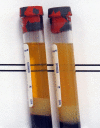Hypertriglyceridaemia unresponsive to multiple treatments
- PMID: 26468219
- PMCID: PMC4612542
- DOI: 10.1136/bcr-2015-210788
Hypertriglyceridaemia unresponsive to multiple treatments
Abstract
A 52-year-old man with a longstanding history of hypertriglyceridaemia (approximately 7 mmol/L (600 mg/dL)), unresponsive to treatment, presented to a lipid-specialty clinic. Additional triglyceride-lowering therapies were added with no effect. It was then noted that despite the apparent hypertriglyceridaemia, his serum sample was clear. A 'glycerol blank' was then requested from an advanced lipid laboratory, which reported a triglyceride value of 0.7 mmol/L (62 mg/dL). These findings suggest isolated asymptomatic glycerol kinase deficiency (GKD) or 'pseudohypertriglyceridaemia'. The falsely elevated triglyceride values in such individuals are a result of excess serum glycerol and clinical laboratories measuring glycerol to report triglyceride concentrations. After discontinuation or modification of the patient's primary triglyceride-lowering agents, the lipid panels and triglyceride values remained comparable to previous readings. Recognition of asymptomatic GKD is important to prevent unnecessary treatment and overestimated cardiovascular risk.
2015 BMJ Publishing Group Ltd.
Figures
References
Publication types
MeSH terms
Substances
LinkOut - more resources
Full Text Sources
Other Literature Sources
Medical

